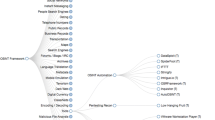Abstract
Recently, a tremendous advancement has been made in the field of network and communication. A usage of pervasive applications for machine-to-machine communication is increasing day by day. Digital forensic examiners are facing different type of problems. The most prominent problems among the research community are data overload, data modeling, data characterization and data presentation. This paper addresses these issues by analyzing a dataset of instant messages (IMs) over the period of 2 years and 4-months. Various patterns of interaction between target user and his/her buddies are analyzed through Social Network Analysis (SNA). The strength of relationship e.g. close, fair, temporary, etc. between each pair of users is determined by analyzing their social interaction ratio with respect to the chat frequency of overall network. The characterization of IMs is to identify the interaction between various actors from Social Network of Instant Messages (SNIM) and the prominence of certain actor within social network. Graphs and matrices are used to model and characterize the SNIM and suitable techniques are identified for computational analysis of SNIM. Centrality measures such as degree centrality, betweenness centrality and closeness centrality are taken to determine the connection of each actor with its neighbors and its influence within SNIM. ‘Vizster’ and ‘Prefuse’ are used for graphical representations and to analyze SNIM forensically. The effectiveness of ‘snowball method’ for forensic analysis of dataset graphically is also discussed. In the end the maximum number of immediate ties at step 1 of each vertex are considered to determine the most influential and significant vertices from the SNIM. Various relationship levels are defined on the basis of examiner-defined threshold to conclude the required results.









Similar content being viewed by others
References
WebWatcher. http://www.webwatchernow.com/Record-Instant-Messages.html
Spector Pro. http://www.spectorsoft.com/products/SpectorPro_Windows/
Chat Watch. http://download.cnet.com/Chat-Watch/3000-2150_4-27839.html
Hui SC, Yulan H, Haichao D (2008) Text mining for chat message analysis. IEEE Conf Cybern Intell Syst
Resig J, Ankur T (2004) A framework for mining instant messaging services. Workshop on Link Analysis, Counter-Terrorism & Privacy, SIAM DM
Resig J, Dawara S, Homan CM, Teredesai A (2004) Extracting social networks from instant messaging populations. In: the Proceeding of the 7th ACM SIGKDD Workshop on Link KDD
Jamali M, Abolhhassani H (2006) Different aspects of social network analysis. In the Proceedings of the 2006 I.E. WIC ACM Int. Conf. on Web Intelligence
Resig J, Teredesai A (2004) A framework for mining instant messaging services. In: the Proceedings of the SIAM DM Conference
Access Data, “Registry quick find chart”. http://accessdata.com/downloads/media/Registry%20Quick%20Find%20Chart%20%207-22-08.pdf
Mike D (2006) An examination into MSN Messenger 7.5 contact identification. Digit Investig 3(2):79–83
Wouter SD (2007) Forensic artefacts left by Windows Live Messenger 8.0. Digit Investig 4(2):73–87
Parsonage H (2008) The forensic recovery of instant messages from MSN messenger and Windows Live Messenger. http://computerforensics.parsonage.co.uk/downloads/MSNandLiveMessenger-ArtefactsOfConversations.pdf
Yang Y et al (2010) Forensic analysis of popular Chinese internet applications. In: the Proceedings of IFIP Int. Conf. Digital Forensics, 285–295
Watts DJ, Strogatz SH (1998) Collective dynamics of 'small-world' networks. Nature 393:440–442
Barmpoutis D, Murray RM (2010) “Networks with the smallest average distance and the largest average clustering”, arXiv, q-bio. MN
Wasserman S, Faust K (1994) Social network analysis. Cambridge University Press, Cambridge
Scott J (2000) Social network analysis: a handbook, 2nd edn. Sage Publications, London
Zaphiris P, Pfeil U (2007) Introduction to social network analysis. In: the proceedings of the 21st BCS HCI Group Conference, Volume 2, 3–7 Sept
Goos G, Hartmanis J et al (1973) Network analysis methodological foundations, Lecture Notes in Computer Science, Commenced Publication
Strogatz SH (2001) Exploring complex networks. Nature (London) 410:268–276
Krebs V (2002) Mapping networks of terrorist cells
Fu D, Remolina E, Eilbert J (2003) A CBR approach to asymmetric plan detection. In: the Proceedings of Workshop on Link Analysis for Detecting Complex Behavior, Washington, DC
Thilagam PS (2010) Applications of social network analysis. In: Handbook of social network technologies and applications, Springer, 637–649
Jamali M, Abolhassani H (2006) Different aspects of social network analysis. In: the proceedings of IEEE/WIC/ACM conference on Web Intelligence
Brandes U (2001) A faster algorithm for betweenness centrality. Journal of Mathematical Sociology 25:163–177
Freeman LC (1978) Centrality in social networks: conceptual clarification. Soc Networks 1:215–239
Opsahl T, Agneessens F, Skvoretz J (2010) Node centrality in weighted networks: generalizing degree and shortest paths. Soc Networks 32:245–251
Wasserman S, Faust K (1994) Social network analysis: methods and applications. Cambridge University Press, New York
Acknowledgments
This research was supported by Basic Science Research Program through the National Research Foundation of Korea(NRF) funded by the Ministry of Education(grant number 2013R1A1A20598).
Author information
Authors and Affiliations
Corresponding author
Rights and permissions
About this article
Cite this article
Yasin, M., Qureshi, J.A., Kausar, F. et al. A granular approach for user-centric network analysis to identify digital evidence. Peer-to-Peer Netw. Appl. 8, 911–924 (2015). https://doi.org/10.1007/s12083-014-0250-x
Received:
Accepted:
Published:
Issue Date:
DOI: https://doi.org/10.1007/s12083-014-0250-x




